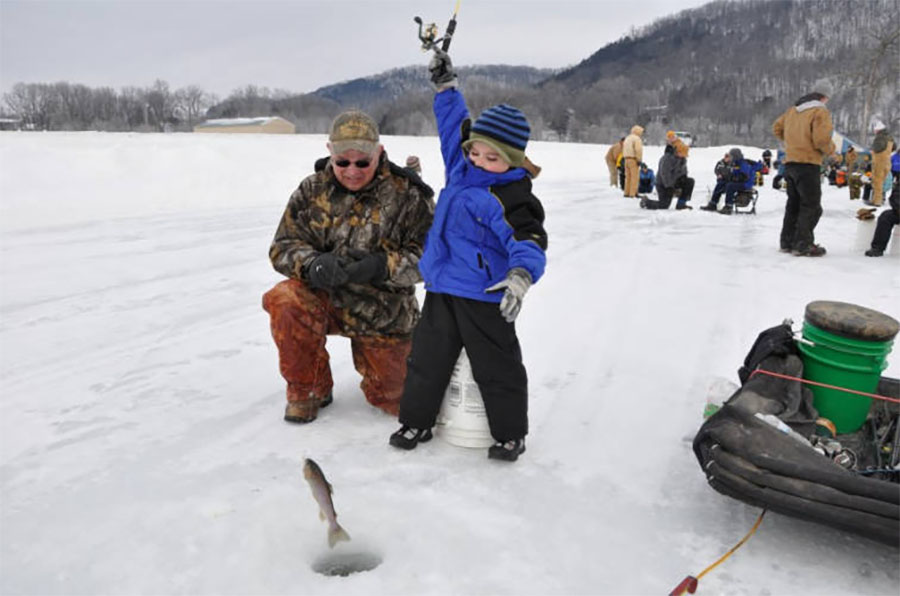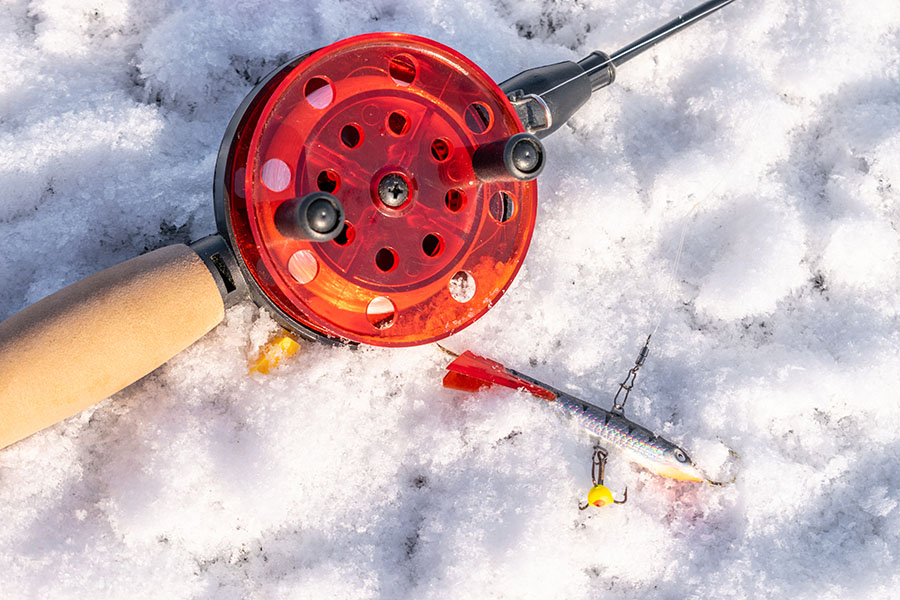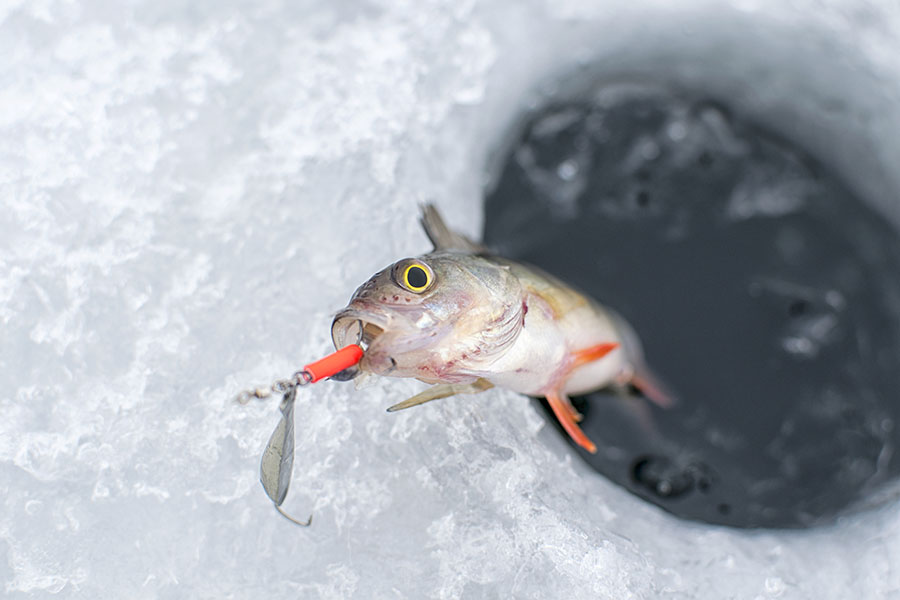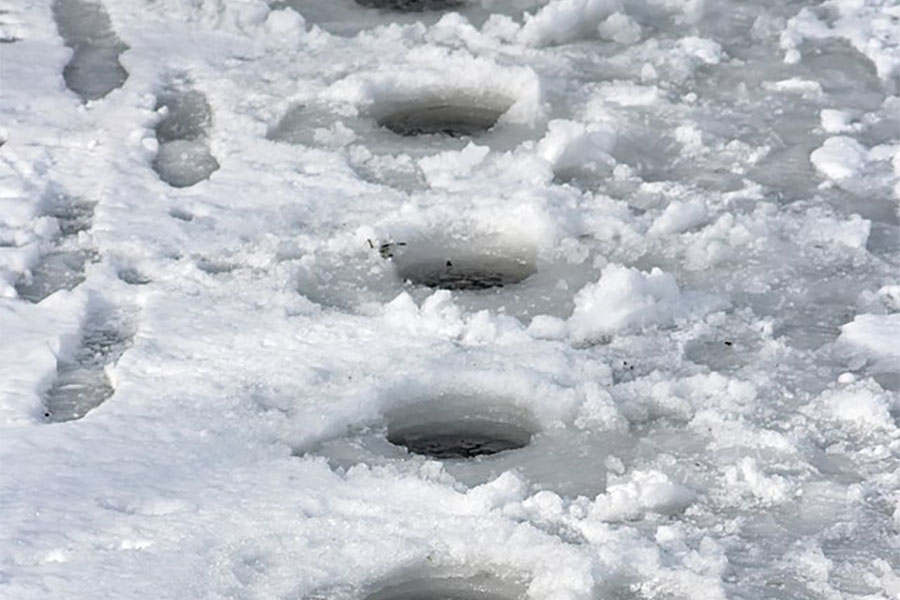When winter’s grip descends over the countryside and all the summer fishing holes freeze over, the ice-fishermen awaken from their long hibernation over the year’s warm, beautiful months. Their primary target? The Perch. These gamefish, in the same family as Walleye, are fun to catch, fun to fight, and make excellent table-fare.
Their great numbers and geographic distribution make Perch the perfect sportfish species to introduce ice fishing to novice anglers. But before you embark on your perch fishing adventure, let me share with you some of the best times, places, tackle, methods, and tricks to improve your chances of landing that jumbo Perch.
- When and Where to Go Ice Fishing for Perch
- When is the Best Time to Ice-fish for Perch?
- States and Lakes for Perch Fishing: The Perch Belt
- Best Spots to Target Perch
- Essential Ice Fishing Tackle and Equipment for Perch
- Best Bait and Lures for Ice Fishing Perch
- The Best Fishing Methods for Targeting Perch Under the Ice
- Tips and Tricks Used by the Pros
When and Where to Go Ice Fishing for Perch

When is the Best Time to Ice-fish for Perch?
Unlike their cousins, the Walleye, Perch have relatively poor eyesight in low-light conditions. This makes the brightest part of the day the best time to drop a line in the water. Mercifully, this is also the warmest part of the day for the angler as well.
Perch are most active just after sunrise and just before the sun sets in the later afternoon. This is also when they feed and the best time to fish for perch. However, perch can be caught throughout the day when ice fishing.
When fishing for purchase during sunrise, it’s best to get set up on the ice before the sun even comes up. This way you can get your bait in front of hungry perch as they move toward their feeding grounds as the sun is coming up providing the first light of the day.
May anglers feel that sunset is the best time of day to target perch. The theory is that as the sun goes down, small invertebrates rise from the lake bottom and remain suspended in the water column where hungry perch feed on them. I’ve certainly had a lot of successful catching perch in the later afternoon while ice fishing, but I’ve caught plenty of perch in the early morning and afternoon as well.
Even though perch have fairly poor eyesight, ice fishing at night can also be productive as long as you use the right bait and technique. The key to night fishing under ice for perch is to present a slightly larger, slower bait that perch are able to locate and catch. Using artificial “glow” lights can also help attract feeding perch in low visibility conditions.
States and Lakes for Perch Fishing: The Perch Belt
States that offer the best perch fishing are located in the Northern U.S. Incidentally, almost all of the lakes in these states freeze up over the winter and provide excellent protection for jumbo perch to fatten up over the colder months of the year.
StateLake / RiverWisconsinLake Michigan, Mississippi River, Lake Winnebago, Lake Mendota, Black Oak Lake, Lake Mentoga, Beaver Dam ReservoirMichiganLake Michigan, Lake Gogebic, Lake St. Clair, Cass Lake, Muskegon Lake, Intermediate Lake, South Lake Leelanau, Higgins Lake, Lake Charlevoix, Munising Bay, Lake Mitchel, Lake CadillacMarylandUpper Chesapeake Bay, Lake Habeeb, Deep Creek Lake, Rocky Gap, Piney ReservoirMontanaHolter Lake, Smith Lake, Thompson Lake, Stillwater Lakes, Echo Lake, Lower Clark Reservoirs, Island Lake, Piskun, Francis, Lake Mary Ronan, Ashley (jumbos), Canyon Ferry Reservoir, Georgetown Lake, Hauser LakeMinnesota3 Mille Lacs, Red Lake, Leech Lake, Upper Mississippi, Round Lake, Gull Lake, Lake Winnibigoshish, Lake Vermilion, Lake Bemidji, Zippel Bay, Oak Lake, Lake Elmo, Lake Harriet, Lake PhalenSouth DakotaLake Waubay, Bitter Lake, Lake Francis Case, Lake Thompson, Waubay Lake, Pikerel Lake, Madison Lake, Goose Lake, Sheridan Lake, Optiz LakeNorth DakotaDevils Lake, Lake Sakakawea, Lake Metigoshe, Lake Darling, Bowman Hayley Lake, Lake Ashtabula, Dickinson Reservoir, Heart Butte Reservoir, Indian Creek Dam, Larson Lake, Blacktail Dam, Antelope Lake, Scooby LakeOhioLake Erie, East Reservoir, Long Lake, North Reservoir, Turkeyfood Lake, West Reservoir, AEP ReCreation Lane (350 lakes and small ponds), Grand Lake St. Marys, Alum Creek, Portage Lakes, Indian Lake, Buckeye Lake, Pymatuning Lake, Indian Lake, Findlay Reservoir, Mosquito Lake, Leesville LakeNew YorkLake Erie, Lake Champlain, Saratoga Lake, Fourth Lake, Lake Ontario, Oneida Lake, Cayuga Lake, Honeoye Lake, Chautauqua LakeUtahFish Lake, Big Sandwash Reservoir, Mantua Reservoir, Pineview Reservoir, Rockport Reservoir, Echo Reservoir, Hyrum Reservoir, Deer Creek Reservoir, Utah LakeIdahoLake Cascade, Cocolalla Lake, Fernan Lake, Upper Twin Lake, Lower Twin Lake, Winchester Lake, Devil Creek Reservoir, Mackay Reservoir, Ririe Reservoir, Spirit Lake, Avondale Lake, Hauser Lake, Hayden Lake, Round LakeIowaBig Spirit Lake, West Okoboji Lake, Upper Mississippi (backwaters), Clear Lake, Brushy Creek, Black Hawk Lake, Iowa Great Lakes, Store Lake, Big Creek LakeColoradoCrawford Reservoir, Rifle Gap Reservoir, Blue Mesa Reservoir, Chambers Lake, Eleven Mile Reservoirs, Harvey Gap Reservoir, Trinidad Lake State Park, Chatfield Reservoir, Lake Granby, Twin Lakes ReservoirWyomingBoysen Reservoir, Keyhole Reservoir, Glendo Reservoir, Bighorn Lake, Lake Hattie, Grayrocks Reservoir, Ocean Lake, Healy ReservoirPennsylvaniaLake Marburg, Sayers Reservoir, Canoe Lake, Laueral Lake, Beechwood Lake, Belmont Lake, Fairview Lake, Gouldsboro Lake, Lake Eire, Lake Wallenpaupack, Lake Wilhelm
Best Spots to Target Perch
Finding a good perch hotspot early will greatly improve your catch rate. Below are few habitats to try when ice fishing for perch.
- Muddy flats — Early, Mid, or Late Winter, large mud flats with some vegetation on the bottom are a favorite hunting ground for Perch. These mudflats are a breeding ground for aquatic insects and their larvae which perch love to feed upon during the brightest and warmest parts of the day.
- Rocky bottoms — These zones provide everything Perch want. Crawfish, minnows, and insect larvae can be found amongst the rocky cover, which retains warmth from the winter sun.
- Depth — A highly debated topic amongst perch anglers is optimal depth to fish. The consensus for the best depth across most lakes is 8 to 20 feet deep. If you want to try something more adventurous, I try to target deeper basins in lakes, which can be over 50 feet! During mid-winter smaller perch may hold to the shallows, but the jumbo perch are going to be found in deeper waters.
- Weedy areas — during early winter, at first ice, target perch near areas of weeds and vegetation. Slower-tapering drop offers near vegetation lines are also ideal areas to find feeding perch. Just remember, not all perch stay in the same spot. Try weedy areas where there are minnows as well as soft-bottom flats where there are aquatic insects.
Essential Ice Fishing Tackle and Equipment for Perch

The Basics
Ice-fishing can sound like a deceptively simple undertaking. However, ice-fishing comes with its own specialized tackle and equipment needed to be successful and comfortable on the ice. I have outlined some equipment and tackle every angler should have when ice-fishing for Perch, regardless of the lake or conditions.
Tackle
The basic tackle required for ice fishing perch include rod, reel and fishing line.
- Reel — Smaller 1000-2000 size reels are ideal for Perch fishing. Most have great line capacity and are not burdensome while fighting fish.
- Rod — For ice-fishing, ultralight rods are effective due to their sensitivity and short length, which is ideal for fishing a drilled hole in the ice.
- Line — Using light, fluorocarbon lines from 2lb to 6lb will allow for the natural presentation of the bait or lure used.
Equipment
The following basic equipment required for ice fishing (except maybe the snacks.)
- Ice Drill/borer — an electric borer will improve your willingness to drill more holes and improve your odds of catching more perch.
- Depth finder — Knowing your depth is crucial when scouting for fish. A good sonar will tell you how deep the water is and whether or not there are fish in the area.
- Buckets — What fisherman goes fishing without a bucket?
- Chair — Sitting on hard ice with your bare bum is not fun.
- Shovel — To scoop the ice out of your boring hole.
- Some snacks and a hot drink never hurt as well.
Best Bait and Lures for Ice Fishing Perch

Bait vs. Lures? Which Works Best for Ice-Fishing Perch?
Perch are a predatory species that typically eat anything they can fit into their mouths. Logistically, artificial lures are simpler to take with you on an ice-fishing adventure. However, their presentation can sometimes be off-putting to finicky Perch, depending on the size, color, and overall appeal. Live or dead bait has the added attraction of scent and taste but can fall off the hook more easily. Here let’s discuss some of the best baits and lures when Ice-fishing for Perch.
The Best Bait for Ice-fishing Perch
Live bait is an effective alternative to artificial lures regardless of where you are in the world or what you are fishing for. Over time I have found that some live baits work better than others for Perch. I prefer to rig live bait on a drop-shot rig with at least two hooks above the weight.
- Wax worms — My personal favorite; they have great contrast in the water and hold the hook well.
- Minnows — Minnows, though effective, are difficult to keep alive and are a logistical hassle to haul around an icy lake.
- Blood worms and Cut night crawlers — Effective, but their dark slim profile can be difficult to see for a Perch in low light conditions.
Best Artificial Lures for Targeting Perch
When it comes to ice-fishing for Perch with artificial lures, smaller lures typically will out-fish larger lures. When picking from the artificial lures below, it is always best practice to try and find the smallest sizes available. Try to keep your lures between 1/16thoz to 1/8th oz. These sizes will maintain the presentation of the lure and will less likely spook wary Perch.
- Buck-shot/flutter spoons — As the name suggests, these lures flutter and flash in the water column. This lure mimics a small injured minnow and is widely considered one of the best Perch lures out there. My favorite colors to use are gold and chartreuse green.
- Jigs — A versatile lure for Perch, the jig can be paired with countless styles and colors of artificial rubber lures that mimic fish, larvae, or insects. My favorite set-up is a 1/16thoz jig head with a 2inch pink curly tail grub.
- Spinners — The spinner has an open blade that rotates and generates vibration as the angler jigs it through the water. My favorite color is chartreuse with a bronze blade. Work the spinner up and down the water column until you find the correct depth.
- Puppet Minnows — These lures are a type of rattletrap with hooks on the front, back, and bottom of the lure designed for vertical ice-jigging. My favorite colors to use are bright greens and pinks.
- Sabiki Rig — Although primarily used for catching baitfish in the ocean, my favorite lure for ice-fishing perch is the Sabiki Rig. Up to 10 hooks descending 10 feet deep, this lure system covers a large portion of the water column and can land you multiple Perch at a time if the bite is on.
The Best Fishing Methods for Targeting Perch Under the Ice

- Jigging — This method is an active form of perch fishing where you are in control of the rod and reel at all times. The idea is to “jig” the lure or bait up and down the water column to attract Perch via the vibration and flash of the bait or lure. This method is ideal when the fish are actively hunting for prey.
- Dead-Sticking — This method is a passive form of perch fishing where the rod is “fixed” in place on a hole while the angler is further away, getting some coffee, or warming their hands by the fire. This method is ideal when the bite is slow, and you have multiple rods set up across an area.
Tips and Tricks Used by the Pros
Of course, as with any type of fishing, there are a couple of tips and tricks that will drastically improve your chances of finding and landing that jumbo perch of your dreams. These tips will separate you from most of the lake chumps and inevitably will lead to you landing larger and more Perch.
Tip 1. Drill holes systematically and drill many. When scouting an area for Perch, it’s best to drill multiple holes far apart to cover as much of an area as possible. Covering different bottom terrains and depths will drastically improve your chances of finding Perch.
Tip 2. Tip your artificial lures with bait. Try tipping the hooks of your lures with minnow heads or wax worms for added scent and presentation.
Tip 3. Keep your line light and invisible. Lighter lines will provide a better presentation of lures and bait for finicky Perch.
Tip 4. The best size to harvest? The best size perch to harvest is around 8-12 inches. Anything smaller is too tricky to fillet; anything more significant will typically be older and have parasites.
Conclusion
Regardless of how many stories I can tell or recommendations I provide. The best way to learn any new area or a fishery is to get out there and try it yourself. Ice-fishing for Perch is an enjoyable pastime, and always manages to keep those winter blues at bay for myself and thousands of others like me. So the next time you see those crazy people sitting in the middle of a frozen lake and thinking, “Why would anyone want to do that?” know that angler is probably catching delicious Perch and having fun doing it. So grab those overalls, tie on a buck-shot, and bore some holes in that frozen lake. You won’t regret it.











































